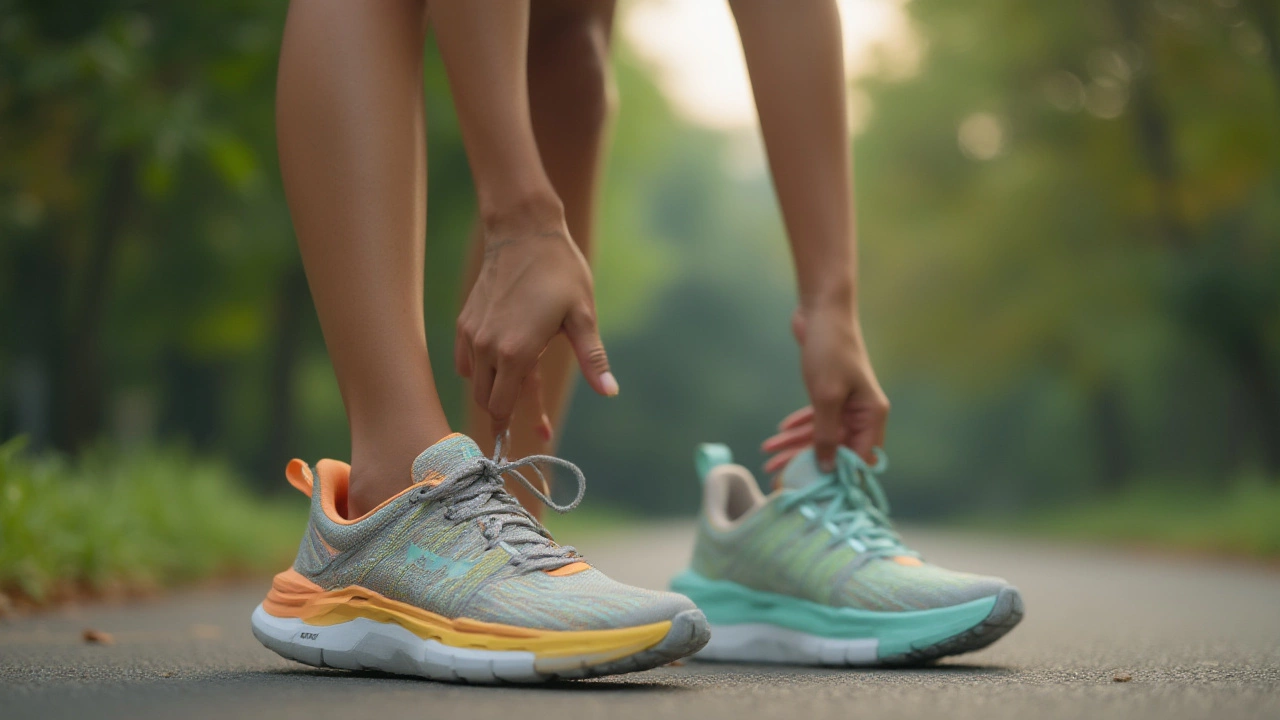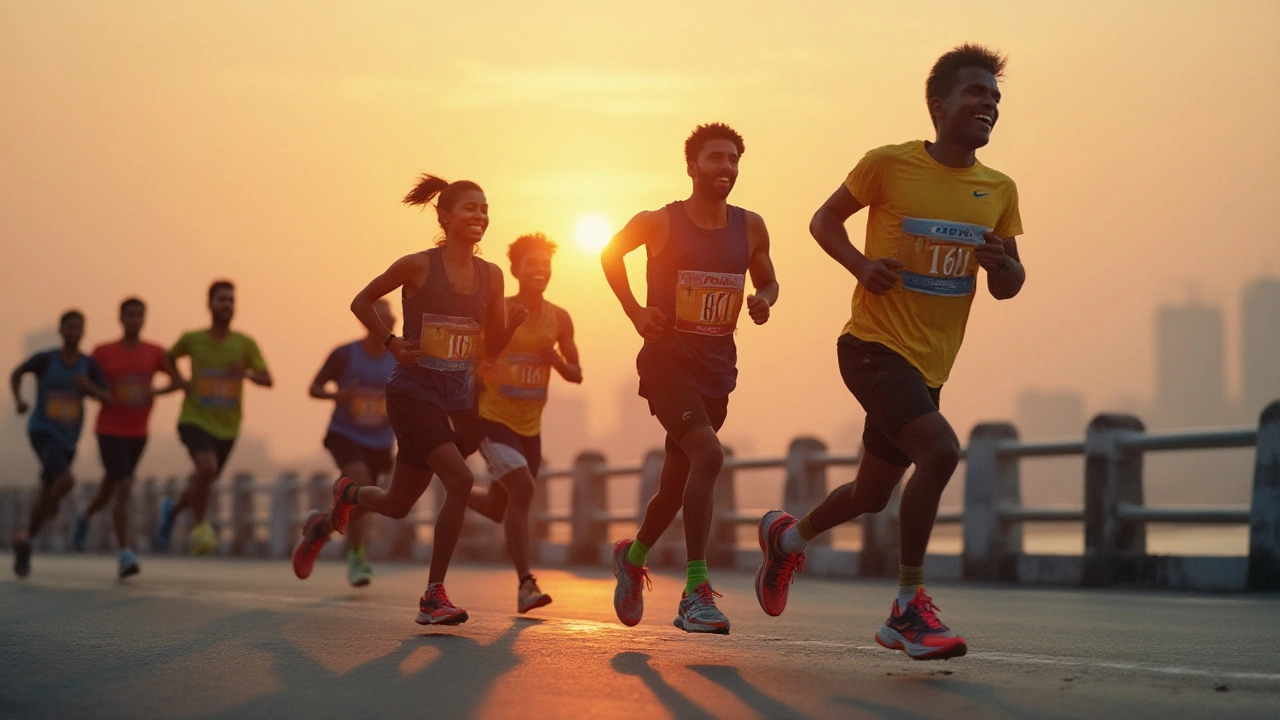Two words: maximal cushioning. Walk into any park, running event, or gym in 2025, and you’ll spot those oversized, cloud-like shoes everywhere. It’s no exaggeration—Hokas have pretty much taken over the running world. But what’s behind the hype? People aren’t just buying a chunky shoe for the look. The thing is, once you’ve run in Hokas, it’s hard to go back to anything else. And here’s the wild part—these shoes started as an experiment for mountain runners. Today, they’ve become a top pick for everyone from weekend joggers to hardcore marathoners. Let’s get into why Hokas are so great and if they really live up to all that buzz.
What Makes Hokas Different?
Think about slipping your foot into something that feels more like a pillow than a shoe. That’s the trademark Hoka feeling: soft, supportive, almost bouncy underfoot. The technical magic starts with their massive midsole—twice as thick as traditional running shoes. Some people call them "marshmallow shoes" for a reason. This super-plush foam absorbs shock in a way that other brands are still trying to figure out. Whether you’re pounding pavement or rolling your ankles on trails, Hokas keep impact to a minimum. That means your legs and joints are less likely to feel beat up after a long run.
Here’s something else to chew on—Hoka’s original design came from ultramarathoners who needed an edge over brutal mountain trails. Jean-Luc Diard and Nicolas Mermoud, two French trail nuts, asked themselves if they could make a shoe that combined max shock absorption with stability. The answer? A shoe that looked more like a moon boot at first, but worked wonders. Fast forward, and Hoka’s patented Meta-Rocker geometry gives every stride a gentle forward roll, almost like you’re being nudged along with each step. This small design twist actually does help most runners go a bit farther, and a bit faster, with less strain on their calves and knees.
But Hokas aren’t just about squishy foam. Flip them over and you’ll find durable rubber outsoles designed for both urban streets and rocky trails. The shoe’s wide platform creates a stable base—no more feeling like you’re about to tip over if you land on a tree root or curb. Hoka uses lightweight, breathable materials for the upper, so even the chunkiest models don’t feel hot or heavy. Their iconic early models, like the Bondi, Clifton, and Speedgoat, are still around and keep getting updated every year based on real runner feedback. That’s probably why so many runners stay loyal once they’ve tried them—Hokas keep evolving.
If you’re into the details, recent studies from 2024 by Runner’s World and the American College of Sports Medicine confirm what fans have been saying: Hokas reduce ground reaction force more than leading competitors. Translation? Less pounding means less fatigue. One of the wildest facts: Hoka sales jumped more than 60% in the past three years, catching up to the big names and pulling off something of an upset in the sneaker world. Celebrities and pro athletes get them for free, sure, but even doctors recommend them for people with plantar fasciitis, shin splints, and arthritic knees. That’s not just clever marketing—it’s science and a ton of word-of-mouth success stories.

How Hokas Fit Everyday Life (Not Just Running)
No, you don’t have to be clocking marathon splits to get value out of Hokas. In fact, a huge chunk of Hoka fans just want comfy shoes for walking the dog, chasing kids, or staying on their feet at work. Nurses, teachers, and waiters swear by them. Ever stand up for eight hours straight and still feel good at the end of the day? That’s not just a runner’s dream anymore—it’s a real perk with these shoes.
The real secret weapon is the wide range of styles. You don’t need the top-end trail racer model unless you’re planning to hit rugged terrain, but even the street-friendly picks like the Clifton 12 or Arahi 8 feel like a treat after a long walk. They’re not just for performance heads or gear nerds. People recovering from injuries, or just starting out with running, say they notice less pain on day one. If you deal with any kind of chronic foot discomfort or have wide or flat feet, Hokas come in a range of fits—often something that other big brands don’t bother with. They even have slip-on recovery shoes for after a workout or shower.
If you care about style, the days of Hoka being "ugly dad shoes" are long gone. The 2025 lineup has way more streamlined options, wild colorways, and crossover models you’d actually want to wear outside of workouts. Fun fact: recent fashion collabs had Hokas in Paris runways and major sneaker blogs, so don’t be surprised if you spot influencers or your coolest friend rocking them at brunch.
But the comfort and low impact benefits go beyond looks and trends. Reports out of Cleveland Clinic and several podiatry networks show that patients who swapped into Hokas reported less foot fatigue by week two, compared to their old shoes—even those with prescription orthotics. The difference is the foam stack absorbs energy, so when you’re standing or shuffling for hours, you don’t get that burn under the ball of your foot. And if you’ve ever worried about rolling your ankle, Hoka’s wider base (especially with models like the Bondi X and Gaviota) practically eliminates that awkward sideways wobble. That wider platform also makes them a solid choice for folks with balance challenges or neuropathy issues.
Another trick: Hokas come in vegan and recycled versions, so you aren’t stuck with leather or old-school materials if you want to keep your choices eco-friendly. The company launched a big sustainability push in 2023, rolling out several models with plant-based mesh, recycled foam, and biodegradable soles. If that’s your thing, look for the special badges on their site—these pairs cost the same as the regular ones. And don’t toss out your old Hokas; there are recycling programs in most big cities now that accept worn-out running shoes to turn into playground surfacing, track material, or even new footwear.

Tips and Surprising Facts for Getting the Most Out of Your Hokas
If you’re ready to give Hokas a shot, or you want to squeeze more miles out of your current pair, a few pro tips can make all the difference. First things first: fit matters more than ever with thick-cushioned shoes. Hokas are famous for their plush feel, but getting the right size is crucial—not too loose, not too tight, since the foam will compress and break in over time. Try them on in the afternoon when your feet are a bit swollen—most people don’t realize they size up half a size because their feet expand during a run or long walk. Hoka’s size chart is pretty accurate, but if you’re in between, opt for the slightly larger size.
With Hokas, you don’t need to "save" them for runs only. Their foam is tough, but it also responds best when you rotate them with another pair—you’ll get more spring and longer life if you give the shoes a day off now and then. Most regular runners get 400-500 miles before the midsole starts feeling flat, but walkers and casual wearers often get an extra hundred miles or more. Don’t forget to check the tread: if you’re seeing smooth, bald spots or any wobbly edges, it’s time for a new pair—worn-out foam doesn’t support your feet the same way and could leave you with aches or injuries.
Don’t rush your first miles in Hokas, especially if you’re coming from a flatter or minimalist shoe. That thick foam and rocker design can change how your feet and legs hit the ground. Ease in with shorter runs or walks for a week and let your muscles adjust. Several high school cross-country coaches found kids risked blisters if they switched too quickly—so don’t be those kids. Grab some performance socks with a snug fit, since the Hoka uppers are roomy and can allow extra movement.
Another tip: if you use orthotics or custom insoles, Hokas have removable footbeds in almost all their top models. No need to swap out comfort if you already have something that works for your arches or heel. And if you want extra support, go for the stability line—like the Arahi or Gaviota. Neutral runners or folks wanting something lighter will find the Clifton or Mach a sweet spot between cushion and speed. Hokas even launched carbon-plated racers, like the Rocket X, for runners chasing PRs—those offer a firm, responsive ride without giving up that famous floaty feel.
Here’s the kicker: Hokas run cool in hot weather. Their mesh uppers breathe better than most shoes with the same cushioned build, so you won’t get swampy feet in July (trust me, Houston summers taught me this lesson the hard way). And if you ever get caught in the rain, Hokas drain and dry faster than old-school foam shoes, so no more sloshy insides after a spring shower.
One last thing: if you’re buying online, make sure to check Hoka’s return policy. They’re known for a no-questions-asked trial—30 days of running or walking, and you can send them back if you don’t love them. That’s a huge risk-free way to see what all the fuss is about. If you’re lucky enough to live near a running specialty store, swing by and get fitted—nothing beats walking around and feeling the shoes in person.
The bottom line? Hokas deserve their rep. Whether you’re fighting morning joint pain, aiming for a marathon, or just hate the usual foot fatigue at the end of the day, these shoes can give you a serious upgrade. And with their mix of science-backed design, surprising style, and patient-friendly comfort, it’s easy to see why so many feet are sliding into Hoka’s world. Ready to try the hokas magic?
